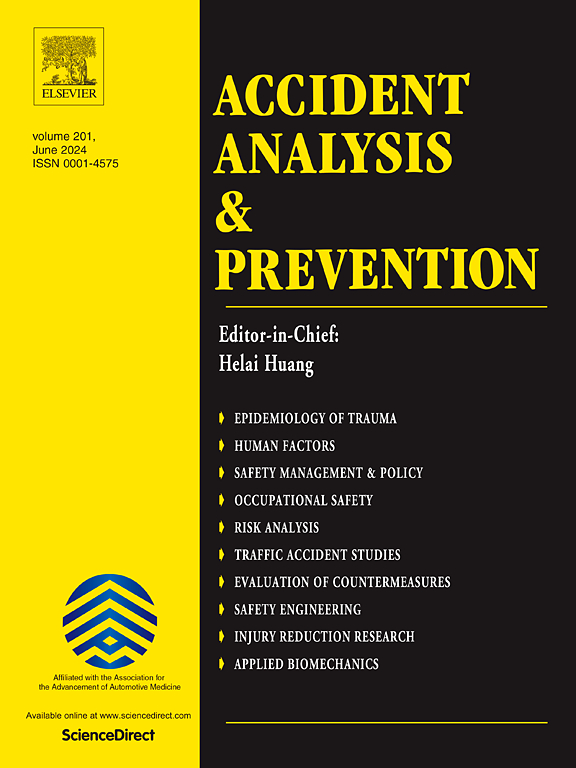A discrete choice latent class method for capturing unobserved heterogeneity in cyclist crossing behaviour at crosswalks
IF 6.2
1区 工程技术
Q1 ERGONOMICS
引用次数: 0
Abstract
Conflicts between cyclists and motorized vehicles at crosswalks often lead to severe collisions. The varied behaviour of cyclists at these crossings introduces unobserved heterogeneity. Despite this, there is a notable research gap in studying the cyclist behaviour at roundabout crosswalks. To address this gap, we propose a discrete choice latent class method to capture the multi-level latent heterogeneity in cyclists’ crossing behaviour at roundabout crosswalks. Latent heterogeneity can be captured at multiple levels: site-level, interaction-level, choice-attribute level, and individual-level. This method, rooted in behavioural theory, aims to provide a deeper understanding of cyclists’ crossing decisions, enhancing safety measures at these intersections. We present an application of the proposed method to two publicly available drone datasets of naturalistic road user trajectories at roundabouts, including 8 roundabout sites that exhibit some level of similarity to minimize site heterogeneity. We capture the latent heterogeneity in the cyclists’ membership to a distinct behavioural class at two levels using these datasets: the individual level, represented by the speed of the cyclist as they enter the crosswalk, and the interaction level, defined by the presence of vehicles approaching the cyclist. Our findings align with previous studies that emphasize the significance of the initial speed variable in influencing cyclists’ subsequent behaviour and decisions. We identified two distinct classes of cyclists. We hypothesize that Class 1 cyclists, whom we refer to as passers, tend to bypass or overtake other road users at the crosswalk, especially in the absence of vehicles, prioritizing speed and efficiency. We also hypothesize that Class 2 cyclists, referred to as followers, exhibit more cautious behaviour, preferring to maintain a steady pace and avoid overtaking, particularly when vehicles are present. The proposed latent class model effectively captures this behavioural distinction, offering a more granular view of cyclists’ decision-making processes at roundabout crosswalks. A key finding is that the discrete choice model with a latent class structure outperforms the basic model without it, despite having more degrees of freedom, as it achieves a lower BIC and AIC but improved model fit statistic. This demonstrates that latent heterogeneity can be effectively captured, leading to improved predictions and outperforming the basic non-latent class model. Classifying cyclists into distinct behavioural classes not only enhances cyclist safety at crosswalks but also provides valuable insights for the development of autonomous vehicle-cyclist interactions.
在人行横道上捕捉未观察到的骑自行车者穿越行为异质性的离散选择潜在类方法。
骑自行车的人和机动车在人行横道上发生冲突常常导致严重的碰撞。骑自行车的人在这些十字路口的不同行为引入了未观察到的异质性。尽管如此,在环岛人行横道上对骑车人行为的研究还存在明显的空白。为了解决这一差距,我们提出了一种离散选择潜在类方法来捕捉环形人行横道上骑自行车者穿越行为的多层次潜在异质性。潜在的异质性可以在多个层面上捕获:站点层面、交互层面、选择属性层面和个人层面。这种方法植根于行为理论,旨在更深入地了解骑自行车的人过马路的决定,加强这些十字路口的安全措施。我们将所提出的方法应用于两个公开可用的无人机数据集,这些数据集包含环形交叉路口的自然道路使用者轨迹,其中包括8个环形交叉路口,这些交叉路口表现出一定程度的相似性,以最大限度地减少站点异质性。使用这些数据集,我们在两个层面捕捉了骑自行车者在不同行为类别中的潜在异质性:个人层面,由骑自行车者进入人行横道时的速度表示;互动层面,由接近骑自行车者的车辆定义。我们的发现与先前的研究一致,这些研究强调了初始速度变量对骑自行车者随后的行为和决定的影响。我们把骑自行车的人分为两类。我们假设,第一类骑自行车的人,我们称之为过路人,倾向于在人行横道上绕过或超过其他道路使用者,特别是在没有车辆的情况下,优先考虑速度和效率。我们还假设,二级骑行者(即跟随者)表现出更谨慎的行为,倾向于保持稳定的速度,避免超车,尤其是当车辆出现时。所提出的潜在类别模型有效地捕捉到了这种行为差异,为骑车人在环形人行横道上的决策过程提供了更细致的视角。一个关键的发现是,尽管具有更多的自由度,但具有潜在类结构的离散选择模型优于没有它的基本模型,因为它实现了较低的BIC和AIC,但改进了模型拟合统计量。这表明可以有效地捕获潜在异质性,从而改进预测并优于基本的非潜在类别模型。将骑自行车的人划分为不同的行为类别不仅可以提高骑自行车者在人行横道上的安全性,而且还为自动车辆-骑自行车者互动的发展提供了有价值的见解。
本文章由计算机程序翻译,如有差异,请以英文原文为准。
求助全文
约1分钟内获得全文
求助全文
来源期刊

Accident; analysis and prevention
Multiple-
CiteScore
11.90
自引率
16.90%
发文量
264
审稿时长
48 days
期刊介绍:
Accident Analysis & Prevention provides wide coverage of the general areas relating to accidental injury and damage, including the pre-injury and immediate post-injury phases. Published papers deal with medical, legal, economic, educational, behavioral, theoretical or empirical aspects of transportation accidents, as well as with accidents at other sites. Selected topics within the scope of the Journal may include: studies of human, environmental and vehicular factors influencing the occurrence, type and severity of accidents and injury; the design, implementation and evaluation of countermeasures; biomechanics of impact and human tolerance limits to injury; modelling and statistical analysis of accident data; policy, planning and decision-making in safety.
 求助内容:
求助内容: 应助结果提醒方式:
应助结果提醒方式:


